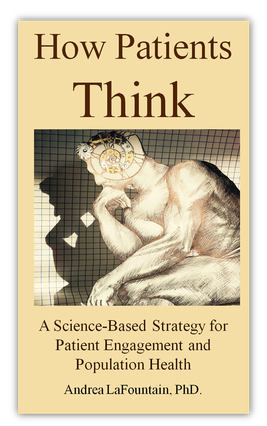 “In the developed world, patient disengagement has become the new killer disease — not the lack of diagnostic devices, trained physicians or efficacious treatment options,” argues Andrea LaFountain, PhD, in her book, How Patients Think.
“In the developed world, patient disengagement has become the new killer disease — not the lack of diagnostic devices, trained physicians or efficacious treatment options,” argues Andrea LaFountain, PhD, in her book, How Patients Think.
Disbanding prescription drugs in advance of doctors’ instructions, postponing lab and diagnostic tests, and avoiding daily blood glucose testing when managing diabetes are just some examples of “how patients think” about health care and the many tasks involved in caring for oneself and the health of loved ones.
But better understanding how patients think — technically speaking, the cognitive neuropsychology underneath the thinking — can help health/care stakeholders better design care processes, programs, and products.
It’s well-documented that health dis-engagement leads to poor health outcomes and higher costs. LaFountain quotes a price tag of $3 billion a year in unnecessary costs for diabetes when Medicare beneficiaries disengage from self-care and follow up with doctors, other healthcare providers, and self-care (taking prescribed drugs, blood sugar testing, exercise, and other DIY healthcare tasks).
Of course, patient disengagement isn’t just a challenge in diabetes: patients diagnosed with all sorts of medical conditions can avoid necessary care, resulting in about $260 bn of annual costs that could be conserved with greater engagement.
LaFountain begins her thesis by pointing to where a patient’s thinking is rooted — and where people can make what seem to be irrational decisions about their health and health care: the executive function system in the brain. This covers: planning and decision-making, error correction and trouble-shooting, situations where responses are not well-learned or require new-new actions for the person, dangerous or technically difficult situation, and scenarios that require overcoming strong habits or temptations. Health behaviors can fall into one or several of these areas.
Complex healthcare situations, like trying to get smoking or deal with the many daily tasks to manage diabetes, can challenge the person trying to make a behavior change due to the health programs lack of understanding how patients think. Thus, the problem is not disengaged patients, LaFountain notes: the problem is the status quo, out-dated models of health care given what we know we know about how the brain works in complex health-decision situations.
In the U.S., that status quo is driven by outmoded claim-based business models which can nudge people in the wrong direction.
LaFountain lays out the case and flow for developing a scientific platform that underpins sound programming for health behavior change, based on cognitive science and health psychology.
Ultimately, cognition precedes behavior, which is “Course Correction #10” in the book. “Without a change in cognition, there is no change in behavior.”
Health Populi’s Hot Points: The status quo LaFountain points to (e.g., outmoded claims-based business models) can nudge people in the wrong direction. In my health economics world, I would point to the adverse impacts of high-deductible health plans, nudging some people to postpone necessary care, or not filling and taking a prescription as instructed. Our colleagues at Sloane-Kettering have termed this “financial toxicity,” another side-effect beyond clinical toxicity, discussed here in Health Populi.
“Course Correction #8” in the book is for current programs to target the sickest patients to impact population health and costs. Currently, so many behavior change programs focus on wellness and healthy sectors, and affluent, more health-literate populations.
As she asserts and understands through research, one size doesn’t fit all in health behave change. This calls for a more deliberate approach to patient engagement and resource allocation, LaFountain writes — sharing care with the right patient with the right intervention at the right time. Sounds straightforward, but that’s not how American healthcare functions in 2016.
Patient engagement can be “the most mutable predictor of patient outcomes,” LaFountain quotes Katherine Kahn in her classic column, Moving Research From Bench to Bedside to Community: There Is Still More to Do in the Journal of Clinical Oncology, February 2008. Recognizing and acting on patients’ central role in driving population health is critical for realizing its full impacts for public health — and optimal individual impacts for personal, personalized health.




 Thank you FeedSpot for
Thank you FeedSpot for